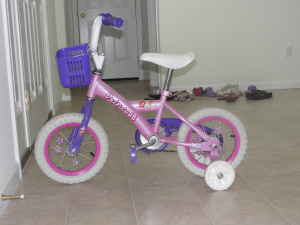 It’s all over the news right now: The story of a 4 year old child racing her bike with training wheels down a Manhattan sidewalk, who hits 87 year old Claire Menagh, who falls, breaks her hip, and dies three weeks later. The story was first reported in the New York Law Journal yesterday (sub required) and in today’s New York Times.
It’s all over the news right now: The story of a 4 year old child racing her bike with training wheels down a Manhattan sidewalk, who hits 87 year old Claire Menagh, who falls, breaks her hip, and dies three weeks later. The story was first reported in the New York Law Journal yesterday (sub required) and in today’s New York Times.
And the essence of the story is this: The mother who was watching her was sued, as was the child. And Justice Paul Wooten has ruled, while the suit is still in its beginning stage, that the case may proceed.
Since the story has now gone viral (it was at the top of Yahoo’s news page), I won’t bother giving a recap, but if you Google the news for “Claire Menagh” you’ll see what’s going on. (Same too with blogs.)
So I’ll cut to the chase: The lawsuit won’t be about taking away the kid’s future Tooth Fairy money or training wheels, it will be about the homeowners’ insurance policy and the extent to which it covers the mother who was watching the child and/or the child.
So this is the law on “negligent supervision” in New York that will, when all the lawyer-talking is done, be read to the jury and govern the ultimate outcome of the case (strictly from a legal perspective) from the perspective of parental negligence. This comes from the Pattern Jury Instructions for New York (PJI 2:261), and is the general language that would then get tailored to the facts of the particular case:
PJI 2:261 Vicarious Responsibility—Family Relationship—Liability of Parent for Tort of Child—Failure to Restrain
A parent is not responsible for the act of (his, her) child, but is responsible for (his, her) own failure to use reasonable care to restrain the child from so viciously conducting (himself, herself) as to (intentionally harm, create an unreasonable risk of harm to) others, provided the parent has knowledge of the child’s propensity toward such conduct. Reasonable care means that degree of care that a reasonably prudent parent would use under the same circumstances. Propensity toward vicious conduct means a habitual tendency to do an act that might endanger the person or property of others.
If you find that the infant defendant habitually assaulted and beat up others, that (defendant-parent) had knowledge of the propensity to do so, and that (defendant-parent) failed to use reasonable care to restrain the infant defendant, you will find that (defendant-parent) was negligent. If, however, you find that the infant defendant did not habitually assault others, or that though (he, she) did, (defendant-parent) did not have knowledge of that fact, or that(defendant-parent) did use such care as a reasonably prudent parent would under the circumstances to restrain the infant, you will find that (defendant-parent) was not negligent.
The comments in the PJI reference a similar case of a child riding on a sidewalk, back in 1937: Steinberg v. Cauchois. The jury found for the plaintiffs but the appellate court tossed the verdict on the particular facts of that case (“The parent is not liable, merely by reason of his or her relationship, for the torts of the child.”). The court then lists 5 categories of potential liability…and the 5th one seems to govern here (though #3 is also possible, depending on the “known propensities” of the child):
There are situations in which the parent may be held liable:
(1) Where the relationship of master and servant exists and the child is acting within the scope of his authority accorded by the parent;
(2) where a parent is negligent in intrusting to the child an instrument which, because of its nature, use, and purpose, is so dangerous as to constitute, in the hands of the child, an unreasonable risk to others;
(3) where a parent is negligent in intrusting to the child an instrumentality which, though not necessarily a dangerous thing of itself, is likely to be put to a dangerous use because of the known propensities of the child;
(4) where the parent’s negligence consists entirely of his failure reasonably to restrain the child from vicious conduct imperilling others, when the parent has knowledge of the child’s propensity toward such conduct; and
(5) where the parent participates in the child’s tortious act by consenting to it or by ratifying it later and accepting the fruits.
Does the underlying suit have merit? Only the facts will tell, and this case hasn’t even gone through discovery yet. If the parent was permitting her child to race down the sidewalk, then she may well be found to consenting to the conduct.
But this case clearly has raised some uncomfortable issues for many with respect to the concept of a 4-year old being sued. Regardless of where you stand on that, the underlying law that is set forth above is likely the crux of the legal matter regarding the parent being potentially vicariously liable for the conduct of the child.
—–
Around the blogosphere we go for various opinions and rants:
The Negligent 4-Year-Old (Volokh @ Volokh)
4-Year-Old Speed RAcer Gets Sued (Mystel @ Above the Law)
4-Year-Old Not Too Young to Get Sued, Manhattan Judge Rules (Jones @ WSJ Law Blog)
About that four-year-old sued for negligence… (J.DeVoy @ The Legal Satyricon)